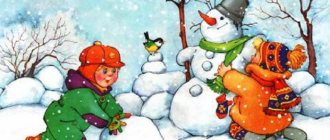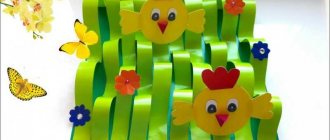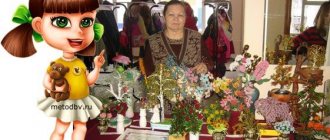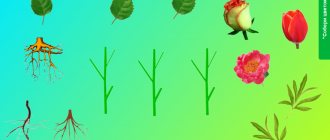Mnemonics for preschoolers
for children with severe speech impairments Municipal preschool educational institution of a combined type, kindergarten No. 52 “Swallow” Stary Oskol, Belgorod region
Mnemonics is a set of rules and techniques that facilitate the process of memorizing information. The use of mnemonics in preschool age occupies a large place. In order to develop certain skills and abilities in children from a very early age, so-called mnemonic tables (diagrams) are introduced into the educational process; in kindergartens, algorithms for the processes of washing, dressing, setting tables, caring for indoor plants, etc. are often used.
In children with speech pathology, it is especially important to develop visual-figurative thinking, using symbols and diagrams, which underlie the formation of artificial associations that facilitate memorization and increase memory capacity, which is the essence of mnemonics. Reliance on a visual image is very important and mandatory, since if, when reproducing the text, this visual image does not appear in the imagination, then the child does not understand this text. Thus, the technique of symbolization is the shortest way to forming the process of memorization and accurate transmission of information that requires verbatim repetition, for example in poetry.
For this, a schematic representation of the individual parts is sufficient, which will facilitate memorization and subsequent reproduction of the entire image in rhymed form. Mnemonic tables are especially effective when learning poems.
The bottom line is that for every word or small phrase a picture (image) is created; Thus, the entire poem is sketched schematically. After this, the child reproduces the entire poem from memory, using a graphic image. At the initial stage, the adult offers a ready-made plan - a diagram, and as the child learns, he is also actively involved in the process of creating his own diagram.
Mastering the techniques of working with mnemonic tables significantly reduces training time. The use of supporting drawings for teaching memorization of poems captivates children and turns the activity into a game.
The visual image that the child retains after listening, accompanied by viewing the drawings, allows him to remember the text much faster. To learn each poem, a mnemonic table is developed and compiled, and pictures are selected for the selected poem (preferably for each line). And so, step by step, a mnemonic table is created.
The next stage of working with the mnemonic table is an emotional, expressive reproduction of the text of the poem. Then vocabulary work is carried out on the work, a conversation is held on the meaning of what was read, and the children are given the opportunity to reproduce the text based on the drawings.
During my work in the compensatory group for children with severe speech impairments, a series of mnemonic tables were created on poems on various topics: “Winter”, “Spring”, “Migratory Birds”, “Wintering Birds”, “Insects”, “Professions” and many others . The mnemonic tables were based on famous poems.
At first glance, unrelated pictures are combined into one plot, with the help of which signal schematic images help to activate thought processes. Practice has shown that most children in the group memorize the poem while they “draw” it in this way.
Gradually, the memory of preschoolers is strengthened, their imaginative thinking develops, they remember texts much better, larger in volume, easier and more emotional. With this method of working, the entire poem is remembered.
Learning has become a fun, emotional activity for preschoolers, and at the same time the content of the text is tangible, visible, imaginable. After all, one of the rules for strengthening memory and speech says: “When you learn, write down, draw diagrams, draw graphs.”
Other articles on the topic “mnemonics”:
Link to source logopedy.ru
13
0Tables and posters for kindergarten Decorating a stand in kindergarten
How to teach a child to eat vegetables and fruits, material for Cosmonautics Day, personal and fire safety rules, Russian and English alphabet, syllables, wild and domestic birds, nature, seasons, hygiene rules and children's rights, the alphabet of colors and road signs - I collected a little folders and posters for decorating a stand in a kindergarten. I hope it's useful. Enjoy watching!
DOWNLOAD IN ONE FILE… Read more…
More details on the website www.liveinternet.ru
MAGAZINE Preschooler.RF
Card index of games for the development of algorithmic skills in children 4-5 years old(middle group)
- Good bad
Goal: To form in children an idea of good and bad deeds, behavior, the ability to correctly evaluate themselves and others, develop algorithmic skills, and introduce them to the linear algorithm.
Rules of the game:
The game can be played collectively, in pairs or even by one child. Children need to look at the pictures; think about which of them illustrate good actions and which ones - bad; distribute the pictures into two groups “good” and “bad” , attaching them to the rays of emoticons.
Game actions:
Children look at the pictures, divide them into two groups “good” and “bad” , attaching them to the rays of emoticons.
Variety of game options:
- Children are asked to look at the pictures, determine what is good and what is bad, explain their decision, divide the pictures into two groups: good and bad , attaching them to the rays of emoticons.
- Children need to match each card on which a child behaves badly with a card on which a child behaves well in a similar situation.
- "Sticks in a Row"
Goal: to consolidate the ability to build a sequential series in size. Teach to act in a certain sequence.
Content. V. introduces the children to the new material and explains the task: “You need to line up the sticks in a row so that they decrease in length . Warns children that the task must be completed by eye (trying on and rearranging sticks is not allowed). “To complete the task, that’s right, each time you need to take the longest stick out of all those that are not laid in a row,” explains V.
- “Whoever walks correctly will find the toy”
Goal: to teach how to move in a given direction and count steps.
Content. The teacher explains the task: “We will learn to walk in the right direction and count steps. Let's play the game “Whoever walks correctly will find the toy . I hid the toys in advance. Now I will call you one by one and tell you in which direction you need to go and how many steps to take to find the toy. If you follow my command exactly, you will arrive correctly.” The teacher calls the child and suggests: “Take 6 steps forward, turn left, take 4 steps and find a toy . One child can be assigned to name a toy and describe its shape, all children can be tasked with naming an object of the same shape (the task is divided into parts), 5-6 children are called.
- Drawing up geometric shapes
Goal: to practice drawing geometric figures on the plane of the table, analyzing and examining them in a visually tangible way.
Material: counting sticks (15-20 pieces), 2 thick threads (length 25-30cm)
Tasks:
- Make a small square and triangle;
- Make small and large squares;
- Make a rectangle, the top and bottom sides of which will be equal to 3 sticks, and the left and right sides will be equal to 2;
- Make sequential figures from threads: circle and oval, triangles. Rectangles and quadrangles.
- Fun algorithm
The goal of the game is to develop logical thinking and also develop the ability to compose a linear algorithm.
Content. The child is offered cards depicting any algorithm (dressing, undressing, duty), he must arrange these cards in the correct order and build his own algorithm.
- “Build according to the algorithm”
*
The goal is to develop logical thinking and develop the ability to perform a linear algorithm.
Content. The child is given a card with a picture of an algorithm for building from cubes (Lego Duplo), the child must fold it step by step.
- "What's the beginning, what's next, Lego cubes"
The goal is to develop technical thinking and the ability to act according to a given linear algorithm.
Content. The child is offered cards, or Lego cubes, for example, with a fairy tale familiar to him, he must arrange it in the correct sequence of the plot.
- Interactive game “Write a fairy tale”
The goal is to develop mental processes in children, the ability to act strictly in a given algorithm.
Content. This game can be played individually, in a group or with a subgroup of children. Where the child chooses his own character, chooses the time of year, the house and the place where the fairy-tale character will live. After which, starting with the chosen character, he tells his tale.
- Guess where?
Goal: to develop the ability to determine spatial directions from oneself.
Material: toys or objects at the discretion of the teacher
Progress of the game: The teacher hides the toy, and the child must find it, following the teacher’s instructions, for example: “You need to find the toy. First take two steps forward, turn right, take three steps forward... etc.”
- Safety games (Cross the road correctly! Call the rescuers
The goal is to develop mental processes, develop mental abilities and visual perception; learn to correlate the speech form with a graphic image.
Content. In front of the child is a set of cards depicting the correct way to cross the road (actions in an emergency, algorithm for calling the police, medical assistance, rules for safe behavior on the road), the child must lay them out in the correct sequence.
Card index of games for the development of algorithmic skills in children 5-6 years old
Older age
- "Floor Algorithm"
The goal is to introduce children to the construction of the first movement algorithms and master the role of an assistant.
Contents.. The game has a playing field on which pictures are located and there is a set of cards with pictures that are used on the playing field. Option 1 on the algorithm - study the construction of the first movement algorithms. (robot child). The child takes on the role of a ROBOT and performs a sequence of his actions.
The second version of the game - the child takes any toy and, together with it, goes through the algorithm specified by the teacher. For example, a child needs to go from the image of a doll to the image of a car, the child goes in any direction forward, left, right, down, from point a to point b. When moving towards a goal, the child pronounces all the pictures that he encounters along the way.
These games can also be played by two people. One child builds a route, and the other child goes through it. In this game, the child masters the role of a helper.
- Maze games
The goal is to develop thinking and visual memory.
- Labyrinths using Dienesh Blocks
The goal is to introduce cyclic and branching algorithms.
Content. We lay out 8 logical blocks of Dienesh in front of the child and, while he does not see, under one of them we hide a “treasure” (coin, pebble, cut out picture, etc.). The child asks leading questions, but you can only answer “yes” or “no”: “Is the treasure under the blue block?” - “No” , “Under red?” - "No" . The child concludes that the treasure is under the yellow block and asks further about the size, shape and thickness. Then the child hides the “treasure”, and the adult asks leading questions.
- Game "entertaining algorithms"
The goal is to develop in children the ability to compose various algorithms. Learn to create a route algorithm.
Contents - The child needs to lay out in the table from the pictograms the program of the performer’s route according to the diagram. To complete the task, the child uses human figures.
- “Algorithms are interesting - helpers”
The game conditions correspond to the game “entertaining algorithms” .
- Game "decode the picture"
The goal is to teach children to read instructions and develop mental processes
Contents - The child needs to lay out a picture of colored squares on the playing field, according to the location encrypted in the card with the code.
- Game "matrix"
Goal – To teach children to read coded instructions, develop imagination, teach them to work in pairs, together.
Contents - A table containing the encoded information is given. The matrix contains information about the quantities, color and shape of parts needed for construction. While decoding the matrix, the child needs to correlate the information located in the columns and rows.
- Bee Bot robot games
The goal is to teach children structured activities that develop their imagination and offer plenty of opportunities to explore cause and effect relationships.
Content. Children give the logo-robot an action plan and also develop various tasks (adventures) for it.
| Next > |








